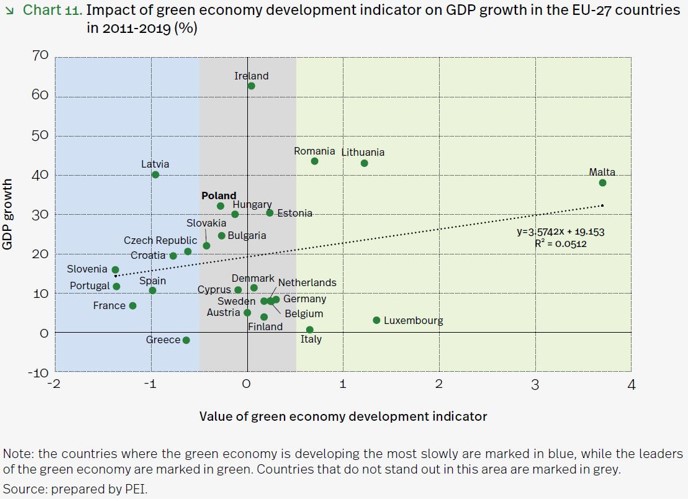The green transition could accelerate economic growth by as much as 1.1 pp per year
Published: 18/05/2022
Poland was 18th out of 27 EU member states in the ranking of the indicator measuring the development of the green economy in 2011-2019. As the PEI’s analysis shows, the development of the green economy is positively correlated to economic growth. A comparison of average total GDP growth in 2011-2019 in the countries with the highest green economy development indicator (25.7%) and those with the lowest (15.4%) points to the benefits of developing green technologies and infrastructure, which translates into a noticeable difference in the rate of economic growth (10.3 pp). Although individual countries’ economic growth is the result of many factors, the results of the model raise questions about the need to choose between raising the standard of living and a sustainable development model. Investing in the green economy does not slow down economic growth, while simultaneously enabling countries to achieve climate targets, according to the PEI’s report entitled The green economy and its impact on the climate and economic growth.
“Our study’s main aim was to estimate the impact of the development of the green economy on GDP and CO2 emissions. To measure this impact, we used a number of indicators, drawing on international classifications and Eurostat, International Monetary Fund and OECD data. The green economy development indicator is made up of 20 factors in 8 categories. As the results of our modeling show, changes in the green economy development indicator created by us represent only 5% of the variance in EU countries’ GDP. However, it explains 43% of emissions variance. This means that investments in the green transition do not have a negative impact on GDP, and simultaneously have a significant impact on the level of emissions,” said Adam Juszczak, an analyst on the climate and energy team at the Polish Economic Institute.
Green economic development is not a contradiction – it is a necessity
According to the model prepared by the PEI, the impact of the increase of the green economy development indicator on growth in GDP per capita in EU member states in 2011-2019 was 0.22, which means that the development of the green economy has a slight but positive impact on economic development. In the case of the green economy development indicator’s impact on CO2 emissions in the EU-27, the factor was -0.66. This means that the development of the green economy contributes to the decrease in emissions in the EU significantly.
A comparison of the average total GDP growth in 2011-2019 in the countries with the highest green economy development indicator (25.7%) and those with the lowest (15.4%) points to the benefits of developing green technologies and infrastructure, which translate into a noticeable difference in the rate of economic growth (10.3%).
Poland is heading in the green direction, but not rapidly enough
According to the PEI’s analysis, Poland is 18th in the EU-27 in the ranking of the green economy development indicator in 2011-2019. The green economy developed the most rapidly in Malta, Luxembourg, Lithuania, Romania and Italy in those years.
Since 1995, the size of the Polish economy has increased by a factor of 2.5, while annual emissions of greenhouse gases have remained more or less stable, at around 400 Mt of CO2 equivalent. This is because emissions per unit of product are becoming lower and lower. In most sectors of the Polish economy, emissions have decreased compared to 1990, with the largest decreases in waste management (by 41%), electricity and heating (32%), and agriculture (32%). However, in some sectors, emissions have increased: by 10% in fuel combustion in industrial processes, by 214% in the transport sector, and by 7% in other sectors (those not included in other categories).
“Based on our model, we conclude that the following have had the most positive impact on the green economy development indicator: the increase in the share of RES in electricity, heating and cooling, and the establishment of an optimal level of feed-in-tariffs for RES. To catch up with the EU’s ‘old’ member states, we need to accelerate the green transition. This would enable Poland to improve the quality of the environment, reduce pollution and increase its ability to meet climate targets, but also strengthen long-term economic growth. Recently, spending on the green economy has been increasing in Poland. 37% of the funds for the Polish economy’s recovery after the crisis allocated between April and the end of 2021 went towards investments with a positive impact on the green transition. This trend should continue,” Adam Juszczak added.
***
The Polish Economic Institute is a public economic think tank dating back to 1928. Its research primarily spans macroeconomics, energy and climate, foreign trade, economic foresight, the digital economy and behavioural economics. The Institute provides reports, analyses and recommendations for key areas of the economy and social life in Poland, taking into account the international situation.
Media contact:
Ewa Balicka-Sawiak
Press Spokesperson
T: + 48 727 427 918
E: ewa.balicka@pie.net.pl
Kategoria: Analysis / Press releases / Report / Reports 2022






